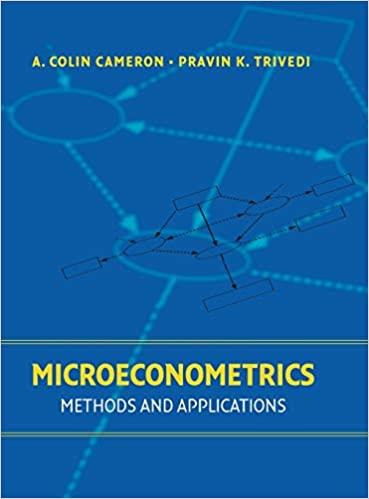This question considers the consequences of misspecification in the Tobit model. The starting point is the model
Question:
This question considers the consequences of misspecification in the Tobit model. The starting point is the model of Exercise 16.1.
(a) Generate with heteroskedasticity by letting , where is chosen to be a suitable positive-valued variable that is correlated with , though not perfectly so. Again set to obtain about of censored observations. Use the MLE for censored normal to estimate this model and compare your results with the corresponding homoskedastic case.
(b) Now consider the impact of nonnormality in the sample. Use the simulation macro available in some packages to carry out a Monte Carlo evaluation based on a sample of 1,000 observations and 500 replications. In each replication generate a sample with censored observations such that the errors are drawn from a mixture of two normals: or with probabilities 0.4 and 0.6 , respectively. Estimate the model using the censored Tobit MLE and compare your results with the normal case. Carry out an analysis of the Monte Carlo output for the two estimators. Draw appropriate conclusions about the impact of nonnormality on the distribution of the Tobit estimator.
Exercise 16.1
This question considers the impact of different degrees of truncation in the Tobit model.
(a) Generate 200 draws of a latent variable , where and the regressor uniform . Choose such that you generate approximately of to be negative.
(b) Generate a censored or truncated subsample by excluding observations that correspond to .
(c) Estimate the model using all 2,000 observations, as if the latent variable were observable, by OLS. Evaluate your results in the light of the theoretical properties of OLS, keeping in mind that you have only one replication.
(d) Using the truncated subsample of only, estimate the model by OLS.
(e) Use the truncated maximum likelihood option to estimate the parameters using all observations. Evaluate your results in light of the properties of the truncated MLE. Compare with the least-squares results from the previous two parts.
(f) Repeat all previous steps using a value of so as to generate 20,40 , and censored observations. Compare your results with those based on censored observations. Hence suggest what is the consequence on the parameter estimates of higher levels of censoring. Reinforce your arguments using theory where possible.
Step by Step Answer:

Microeconometrics Methods And Applications
ISBN: 9780521848053
1st Edition
Authors: A.Colin Cameron, Pravin K. Trivedi




